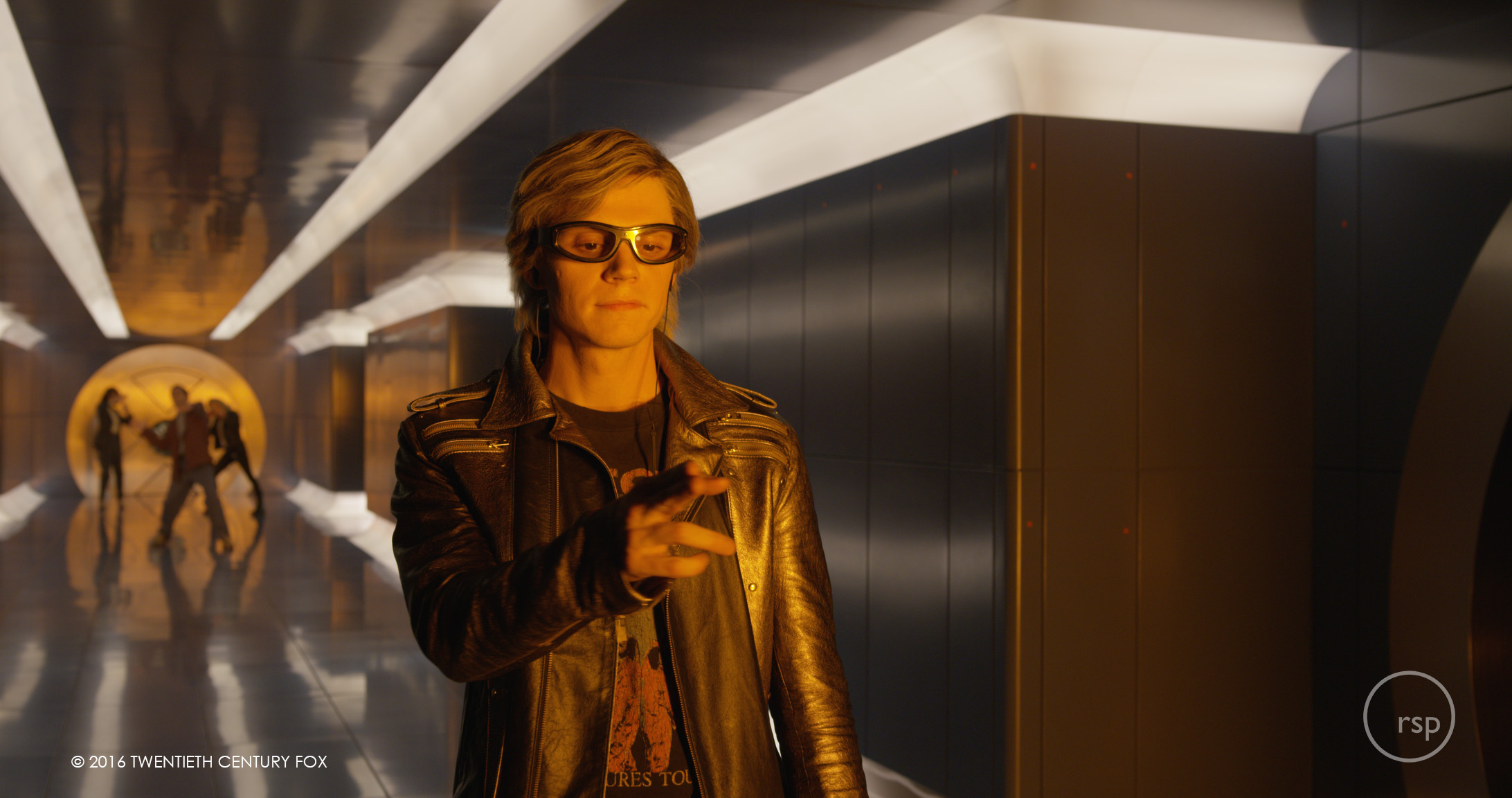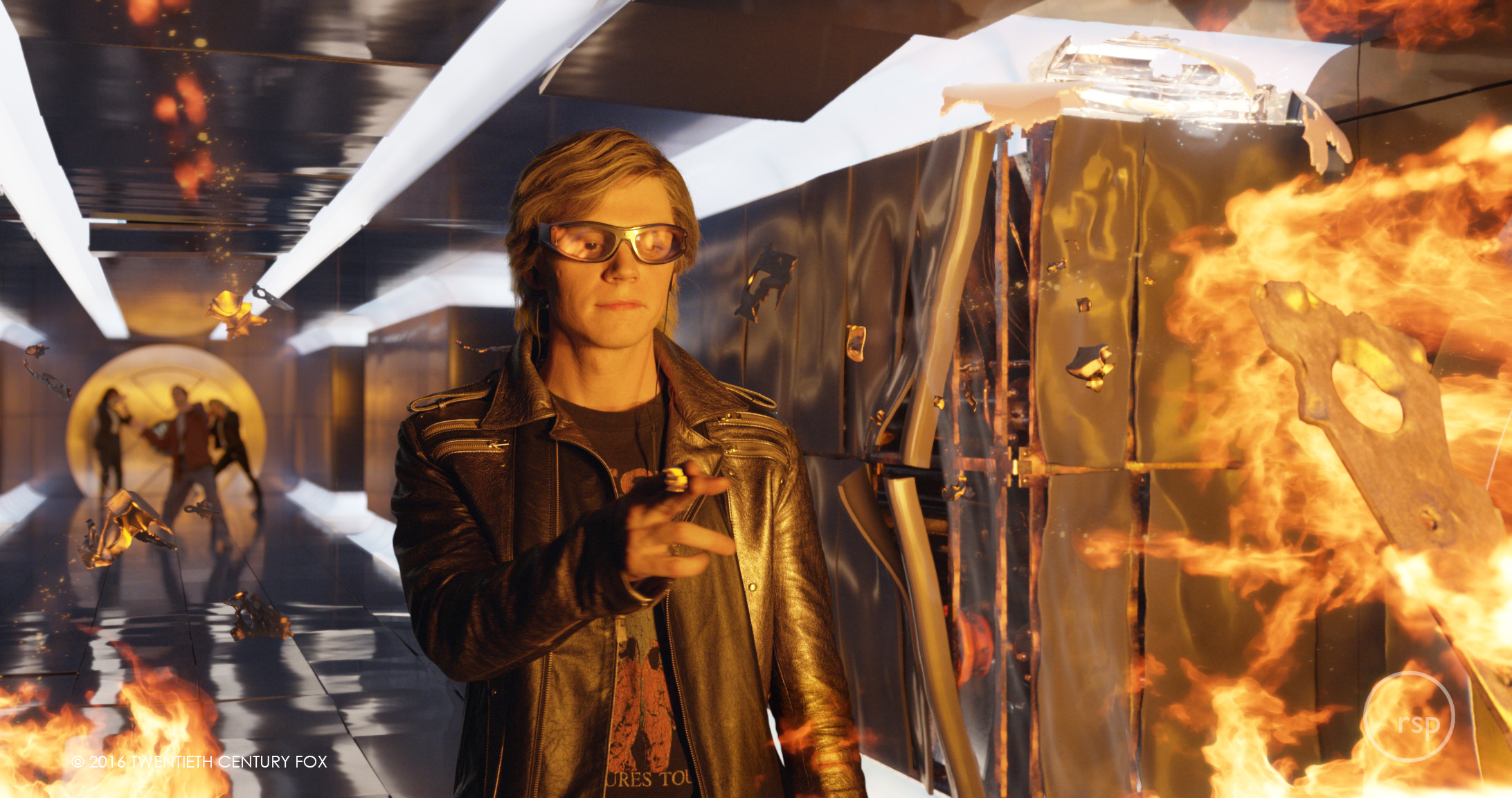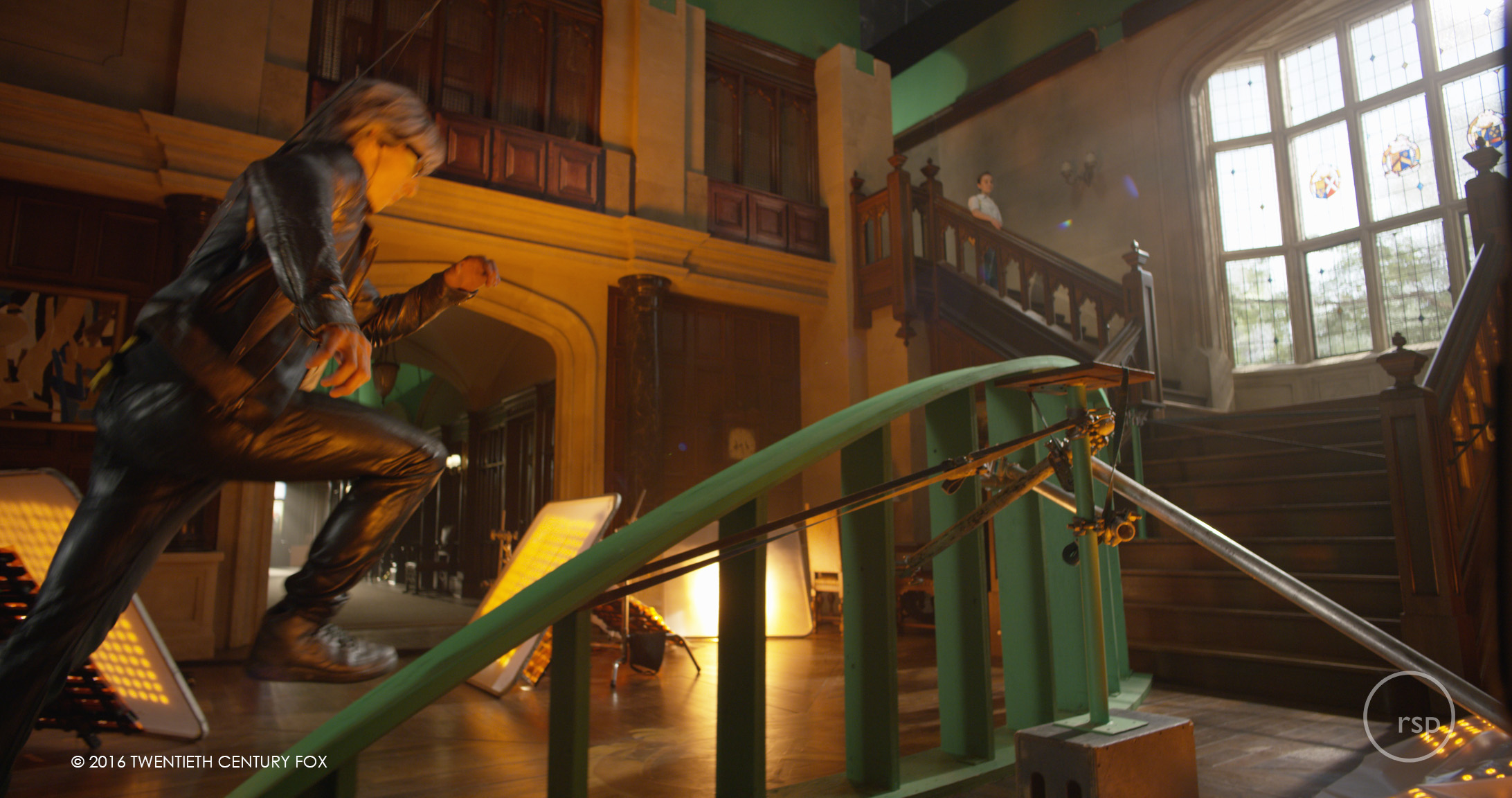The stand-out sequence from the 2016 suite of summer films has to be Quicksilver’s X-Mansion super slow-mo (or super high speed, depending on how you look at it) rescue scene from X-Men: Apocalypse. A stunning mix of practical stunts, effects simulations and re-timed plates, the rescue’s visual effects were orchestrated by Rising Sun Pictures under overall VFX supervisors John Dykstra and Matt Sloan. Here, RSP, which returned to Quicksilver after working on the thrilling kitchen scene in X-Men: Days of Future Past, details how it used Houdini to pull off many of the stunning shots.
The Problem to Solve
Rising Sun Pictures’ principal challenge for the mansion ‘extraction’ sequence was to combine live action footage of Peter Maximoff / Quicksilver (Evan Peters) and the mutants he rescues amid the ever-increasing threat of an explosion set off below the building.
Due to Quicksilver’s speed, exploding pieces of the mansion and various pyro effects grow only incrementally as he races around - shown at different speeds - removing as many of the mutants, and even a dog, as he can find.
For these exploding pieces and pyro effects, Rising Sun Pictures, overseen by its visual effects supervisors Dennis Jones and Tim Crosbie, drew on on an expanding expertise in Houdini simulations, not just taking advantage of the software for the actual sims but also its ability to render out effects and then interpolate the simulation frames over the full length of the shot once appropriate timings had been established.
“I believe Days of Future Past paved the way technologically for X-Men: Apocalypse,” suggests Senior FX Artist and FX TD Kieran Ogden-Brunell.
“Sam Hancock, Prema Paetsch, Timmy Lundin and Dan Wills made it possible on that show to do complex time-warping of DOPs output, high fidelity visual complexity and tools that were intuitive for artists to pick-up. We used that as a substantial launching pad for Apocalypse.”
Pyro-X-Mania
For the explosion simulations in the mansion, Rising Sun Pictures looked first to a reference that had been acquired on set and that the VFX studio held in its own footage library.
“We've had a fair bit of slo-mo pyro footage collected from various sources, including on-set footage, war-documentaries and a series of online references showing different flavours of explosions and fireballs,” outlines Senior FX Technical Director Prema Paetsch. “This was particularly useful for understanding what these events actually look like up close, and breaking down a complex explosion into components that we were trying to re-create in CG.”
Much of the pyro footage shot for real would be replaced with Houdini simulations. Artists began with the pyro shelf-tool to build a basic setup and then tweaked and fine-tuned it until the sim was providing the required behaviour in ‘real-time’.
“We also used a custom approach to adding disturbance to the fire sim, which became a key-ingredient for flamey features,” notes Paetsch.
Houdini’s Up-res Pyro feature was then used to allow for re-timing steps into what was known as ‘Quicksilver-time'. The feature allows for more detail and higher frequency in the sim by increasing voxel resolution.
But more importantly for us, it also has the ability to interpolate existing sim data over a varying passage of time.
Prema Paetsch, Senior FX Technical Director

Rising Sun Pictures controlled the interpolation over a few key frames, making some customizations to the Up-res solve to achieve a predictable sim result.
“Timmy Lundin from our FX team at RSP did some crucial pioneer work to nail reliable re-timing with this method,” says Paetsch.
There were several kinds of pyro required in the scenes, ranging from gaseous to smoky fireballs. Also mixed in were layers of dust, additional smoke, debris and dirt - all generated with Houdini - to help with visual and textural complexity
Houdini was of course also crucial in simulating, in Quicksilver-time, hard surfaces for walls, furniture and other props inside the mansion as the explosion takes hold. To build these elements as digital assets, Paetsch says that the effects and modelling departments worked closely together.
“Between our departments we built a set of guidelines for modelling to adhere to. As a result, the majority of our assets were ‘water tight’ and built physically accurate" says Paetsch.
“Our modeling department rose to the challenge of our guidelines and put their construction hats on. They built as many models as physically correctly as possible. This made our destruction tasks substantially easier, and faster to push through our custom tool-set; and it meant that we had visual complexity rather quickly.”
X-Pert Tools
Rising Sun Pictures’ efforts on the Quicksilver shots were enabled, too, by Houdini’s ability to be adapted to the studio pipeline. That is, the team devised what Ogden-Brunell describes as a “well rounded, modular tool-set” that was ‘toolified’ to meet the needs of the show.
“What started off as a simple idea for building a ‘couple or so’ OTLs,” adds Ogden-Brunell, “ended up involving John Perrigo, Julien Taton, Dan Wills and myself creating a modular tool-set of almost 40 unique and interchangeable OTLs. That meant we could let our artists drive the visuals and have confidence that the procedural nature of Houdini would take care of the scalability while our destruction tool-set handled the complexity.”
This modular tool-set allowed hundreds of separate assets per shot to be almost entirely automated through the effects department and onto lighting and compositing, while effects artists still had creative control over the fracturing, clustering, constraints, forces, activations and overall timing and fell of the destruction.
“We didn't limit out artists,” says Ogden-Brunell, “but gave them tools with fast access to the settings they needed while handling all the complex data management for them.”
“Some of the tools we heavily customised and extended including Houdini's existing SOPs - debris source, voronoi fracture, transform pieces,” explains Ogden-Brunell in further detail. “We then built the rest of the toolset to facilitate our slow motion needs for the Quicksilver sequence, tools for transporting data through our pipeline, and all the challenging edge-case issues that come along with RBDs. Most importantly, in order to facilitate our supervisors (Dennis Jones and Tim Crosbie) and client needs (VFX supe John Dykstra and director Bryan Singer) the toolset allowed ease of use and rapid turnaround for our artists and effects TDs.”


One of the most challenging R&D tasks for Rising Sun Pictures involved solving the slow-motion aspects of the RBD simulations. The team jumped into rapid prototyping of solutions in Houdini and Bullet. “Early on,” says Ogden-Brunell, “we knew the complexity of doing slow-motion, so we targeted our efforts at establishing accuracy with the Bullet solver, customising constraint types and developing ways to prepare mesh.”
“With the rapid prototyping that was at our fingertips, we landed back in SOPs to solve the majority of our concerns. This led us to establish convex geometry, applying forces and activation, calculating mass, and building our constraints, with all our parameters easily viewable and without unnecessary simulation. All of our data was built into SOPs and then supplied to DOPs, and could be spread over the render farm. We also found by doing this, we spent less time rolling dice on simulations and playing with solvers, and more time preparing our data, knowing we'd always get a consistent result!”
Reduced iteration times were a key goal in generating destruction, and the team managed to produce RBDs and particle sims within just hours. Notes Ogden-Brunell: “This flexibility allowed artist Naeem Chudawala to help prototype and test the extensive toolset. He could also drive quick turnaround solutions for changing client briefs. For example, the large window that was destroyed while Quicksilver threw students out the window was originally made of stone. Towards the end of the project, it was decided that it would be more believable if the larger part of the frame was wood. Houdini's flexibility meant that Naeem could switch out the mesh from stone to wood without the need for a re-sim.”
A major technical challenge involved the use of Houdini to fracture and simulate assets while picking selected sections of simulations to pass back through to animation.
“This proved difficult initially,” admits Ogden-Brunell, “but with the help of Rising Sun’s Sam Hodge in pipeline and Silvina Rocca from SideFX’s support team, we were able to get an exporting process with Alembic. This exporting technique resulted in a more reflective scene graph for use in Maya for rigging and animation.”
“We round-tripped this, attaching the highly art-directed animation to our existing simulations for interaction with Quicksilver.
Exaction for Extraction
Faced with a mammoth task for the extraction sequence, Rising Sun Pictures brought to the table a high degree of creative flair and flexibility to solve its many technical hurdles. “For example,” describes Ogden-Brunell, “one of our senior artists Ting Yun Lu was able to focus on the bathroom sequence, quickly iterate versions and make some rather pretty destruction. Lu could build set-ups and hand them over to other artists and Rising Sun’s graduates, allowing them to run shots with little lead time on learning the full complexity of RBDs.”
Ogden-Brunell says that Houdini “gave us a modular toolset that did the heavy data lifting for us. We had flexibility to overcome an array of technical challenges, from breaking glass, walls, parquet flooring, bathrooms and classrooms, to an entire mansion whilst, most importantly, allowing our artists to do art.”
コメント
Please log in to leave a comment.